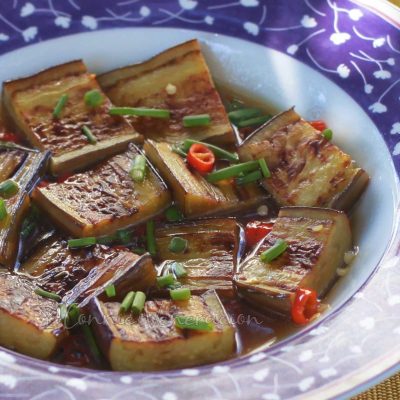It’s popularly called monggo guisado or ginisang monggo in the Philippines, but that’s a misleading name for this dish. Dried mung beans take a long time to cook; otherwise, your teeth will crack when you try to chew them. The long and slow cooking that mung beans require gives the dish the characters of a stew.
Many years ago, my procedure for cooking mung beans was to boil them for about half an hour then dump them into the blender to break them up. The intention, of course, was to cut down on the cooking time. The mung beans were added to sauteed onion, garlic, tomatoes and thinly sliced pork, and everything cooked over low heat until the starch from the beans turned the cooking liquid into a thick broth.
That was before we owned a slow cooker. After I realized how much easier it is to cook dried mung beans in a slow cooker, I never reverted to my old method.
Even then and until now, I don’t press the softened mung beans through a strainer to remove the skins. Much of the nutrients are in the skins; the center is starch. Why would I keep the starch and get rid of the nutrients? That wouldn’t make sense.

I still parboil the beans though to give them a headstart. I rinse the mung beans until the water runs clear, drain then, dump them into a pan, cover them with water, boil them for ten minutes and leave them to soak in the hot water while I prep the rest of the ingredients.

I brown pork belly before slicing them. Partially cooked meat is easier to cut into thin slices. Browning gives the pork a deeper flavor and richer color.
In the rendered prok fat, I saute shallots, garlic and tomatoes just until softened.

Then, I dump the sliced pork, sauteed vegetables and parboiled mung beans (with the liquid) into the slow cooker, pour in bone broth, add fish sauce and cracked black pepper, and start the slow cooking. Four hours on high and the pork is ultra tender, and the mung beans are so soft you can just press them between your tongue and the roof of your mouth.

Once the pork and mung beans are done, I add okra, eggplants and spinach. Not all at the same time though. The okra goes in first, the eggplants are added ten minutes later then the spinach is pressed down into the liquid and the cooking continues for another ten minutes. The seasonings are adjusted and the mung bean stew is ready to be served.
Slow cooker mung bean stew

Equipment
- Slow cooker
Ingredients
- 1 cup dried mung beans green is traditional but yellow will work too
- 500 grams pork belly
- 2 shallots peeled and sliced
- 8 cloves garlic peeled and pounded
- 2 tomatoes cut into wedges
- 3 to 4 cups bone broth I used beef but chicken or pork bone broth will give good results too
- fish sauce
- ¼ teaspoon cracked black pepper
- 6 to 8 okra halved
- 2 eggplants halved and cut into thick slices
- spinach leaves as much or as little as you like
Instructions
- Rinse the mung beans, drain, dump into a small sauce pan, cover with water and boil for ten minutes. Leave to soak.
- Heat a frying pan, smear the bottom with a little oil and brown the pork belly on all sides. Scoop out and move to a cutting board.
- Cut the pork belly into thin slices then dump into the slow cooker.
- In the rendered fat, saute the shallots, garlic and tomatoes.
- Add the sauteed vegetables to the pork then pour in the mung beans with the liquid.
- Pour in three cups of bone broth and fish sauce (see notes) then sprinkle in the black pepper.
- Set the slow cooker on HIGH and cook for three hours and forty minutes.
- Open the cooker. If there is too little liquid to cook the vegetables in, pour in the remaining cup of broth.
- Stir in the okra, close the cooker and cook for ten minutes.
- Open the cooker again, stir in the eggplants, drop in the spinach and press down into the liquid.
- Close the cooker and cook for another ten minutes.
- Taste. Add more fish sauce and black pepper, or both, if needed, before serving.




